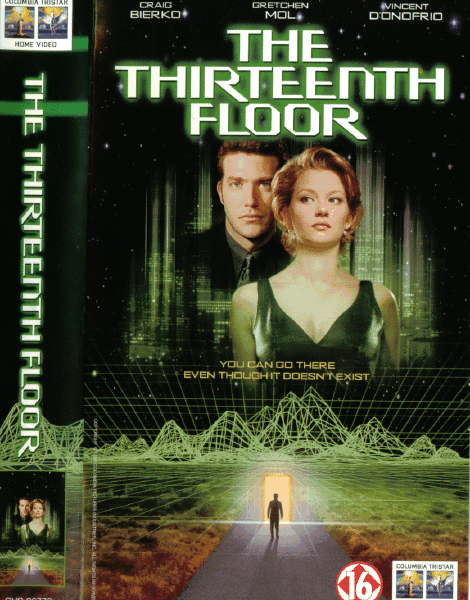Yet another Brokeback Mountain parasite: Broke Mac Mountain.
This actually dovetails nicely with discussions we’ve been having in COM 487 Internet & Society about the difference in what Mac vs. Windows users “value in a machine.”
I devised my blog entry on the topic of “A Tale of Two Aesthetics“, and excerpt of the book Life on the Screen: Identity in the Age of the Internet by Sherry Turkle.
Class was interesting enough tonight.
After class, I asked the professor, “What are your thoughts about why The Thirteenth Floor was classified in the Horror section of the video store as opposed to the Science Fiction section?”
 |
 |
 |
She seemed, well, horrified, that it was. I see that IMDB classifies its genre as: Mystery / Sci-Fi / Thriller.
After class, I dropped by home, ate a Lean Cuisine, and headed down to Helios to study.
For about the entire two hours I was there, I messed around with LambdaMOO, which was somewhat interesting, but more frustrating than anything else. A week from Wednesday, I have to do my research presentation on this piece of crap.
Once home, in my bed, on my laptop, using my iPod ear buds for the sound, and eating a mini-bag of Orville’s Kettle Korn Popcorn, I watched:

Plot Summary: Computer scientist Hannon Fuller has discovered something extremely important. He’s about to tell the discovery to his colleague, Douglas Hall, but knowing someone is after him, the old man leaves a letter in his computer generated parallel world that’s just like the 30’s with seemingly real people with real emotions. Fuller is murdered in our real world the same night, and his colleague is suspected. Douglas discovers a bloody shirt in his bathroom and he cannot recall what he was doing the night Fuller was murdered. He logs into the system in order to find the letter, but has to confront the unexpected. The truth is harsher than he could ever imagine…
For this Wednesday’s class we have to write a blog entry tying 3-5 things in this movie to things we’ve discussed in class about the history of the computer — computer interfaces, specifically.
At Wednesday’s class, the professor is assigning two out of these five questions as our mid-term. I’m not drawn to any of them really. I’m hoping we’ll get to choose, but I think she’s going to choose the same two for everyone.
- In the beginning of the course, we talked about concepts of cyberspace and the Internet (e.g., Robins, 2000). Compare the concepts of cyberspace and Internet, describing how they differ and overlap with each other. To support your answer, give two examples of how cyberspace has been represented and two examples of representations of the Internet (you can exemplify with graphics or words, and draw it from sci-fi, resources such as The Atlas of Cyberspace, etc.). You should also justify why you chose these specific examples. Lastly, point out similarities between the simulation environment in The Thirteenth Floor and William Gibson’s concept of cyberspace.
- Paraphrasing William Gibson (1984), Kevin Robins (2000) argued that “the contemporary debate on cyberspace and virtual reality is something of a consensual hallucination, too” (p.77). Explain Robins’ argument in the light of Gibson’s definition of cyberspace. Connect some of the “utopian views of cyberspace” presented by Robins with the purpose why characters Hannon Fuller and David used to “jack into” the simulation in The Thirteenth Floor? Are there precedents in the way we use the Internet today to the uses presented for the simulation in the film?
- Homeostasis, Autopoiesis and Virtualities are the names of the three cybernetic waves according to N. K. Hayles (de Souza e Silva, 2004). How do the first, second and third cybernetic waves can be applied to the construction of the digital space(s) and the avatars in the film The Thirteenth Floor? Take into consideration the (dis)connection between materiality /information, the definition of human/spatial boundaries as flows of information, the questioning of reality, and the idea that life is made out of code.
- Describe the concept of interface according to Johnson (1997) and to the lectures in which we defined interface. Compare the types of interfaces used to get immersed in the digital space(s) in The Thirteenth Floor to the usual interfaces we use(d) to connect to the Internet and to virtual worlds (giving 3 examples of each). Explain (using examples) how different interfaces might make us have different modes of relationships with computers and the Internet (Murray, 1999, Turkle, 1995).
- According to Murray (1999) computers are spatial mediums for storytelling. Also Johnson (1997) describes computers as “information-spaces”. Explain (a) why computers are spatial entities according to Murray, and (b) why computers are regarded as information spaces according to Johnson. Can the simulations environment in The Thirteenth Floorbe considered an information space, following Johnson and Murray? Give 2 examples of how computers / the Internet / softwares have been represented as a space, explaining why.